Canada, a nation renowned for its breathtaking landscapes and vibrant culture, also boasts a robust and distinctive monetary system. If you’ve ever wondered, What Is Canadian Money Called?, the answer is simply the Canadian dollar. Often abbreviated as CAD, and represented by the symbol $, the Canadian dollar is more than just a medium of exchange; it’s a reflection of Canada’s history, values, and place on the global economic stage.
This guide will delve into everything you need to know about Canadian money, from its historical roots and the various names of its coins and banknotes to its significance in the international financial world.
Understanding Canadian Currency: The Dollar
The official currency of Canada is the Canadian dollar. It’s divided into 100 cents, and is managed by the Bank of Canada, the nation’s central bank. But the journey to the Canadian dollar as we know it today is a fascinating tale of unification and economic independence.
A History of the Canadian Dollar
Before Confederation in 1867, the currency landscape in what is now Canada was quite diverse and complex. British colonies circulated various forms of money, including British pounds, American dollars, Spanish pesos, and even locally issued currencies by individual banks and colonial administrations.
Recognizing the need for a unified monetary system, the newly formed Canadian government, under the Dominion Notes Act of 1870 (now the Currency Act), established the Canadian dollar as the sole official currency. This pivotal decision streamlined commerce and strengthened the burgeoning nation’s economic identity.
Initially, the Canadian dollar’s value was pegged to the British pound and later to the gold standard. However, since 1931, it has operated as a “free-floating” currency. This means its value is determined by the forces of supply and demand in the international foreign exchange market, rather than being fixed to another currency or commodity. This free-floating nature makes the Canadian dollar responsive to global economic conditions and reflects Canada’s economic performance on the world stage.
The Canadian Dollar in the Global Economy
The Canadian dollar is recognized as a significant currency internationally. The International Monetary Fund considers it one of the world’s seven major reserve currencies. This designation speaks volumes about the Canadian dollar’s stability, reliability, and the strength of the Canadian economy, even during times of global economic uncertainty. Being a reserve currency means that many central banks and financial institutions around the world hold Canadian dollars as part of their foreign exchange reserves.
The Canadian dollar is frequently compared to its neighbor to the south, the American dollar (USD). While the CAD usually trades at a slightly lower value than the USD, the exchange rate fluctuates based on various economic factors, including commodity prices (particularly oil, as Canada is a major oil exporter), interest rate differentials, and overall global economic sentiment. At times, the Canadian dollar has approached parity with the US dollar, while at other times, it has traded at a wider discount.
Canadian Coins: A Detailed Look at the Change in Your Pocket
Canadian coins are produced by the Royal Canadian Mint, an institution renowned globally for its craftsmanship and innovative coin designs. Beyond the standard circulation coins, the Mint also produces a wide array of collector coins and special editions, showcasing Canadian artistry and history.
Here’s a breakdown of the coins you’ll commonly encounter in Canada:
Loonie (One Dollar)
The Loonie is perhaps Canada’s most iconic coin. Introduced in 1987 to replace the one-dollar banknote, it’s a gold-colored coin made of nickel and is larger than both the quarter and the dime. Its distinctive name comes from the loon, a bird synonymous with Canada and prominently featured on the coin’s face. The loon is a waterbird known for its distinctive call and is deeply embedded in Canadian folklore and natural heritage.
Toonie (Two Dollars)
The Toonie, or sometimes spelled “Twoonie,” is another uniquely Canadian coin. Introduced in 1996 to replace the two-dollar bill, it’s a bimetallic coin, meaning it’s made of two different colors of metal – a gold-colored center surrounded by a silver-colored ring. The Toonie features a polar bear, a majestic animal emblematic of Canada’s Arctic regions, on one side. The polar bear was chosen to represent Canada’s northern wilderness and the importance of wildlife conservation.
Quarter (25 Cents)
The Quarter, valued at 25 cents (a quarter of a dollar), is a silver-colored coin. It features a caribou, a type of deer native to Canada, known for its impressive antlers. The caribou is a significant symbol of Canada’s vast wilderness and northern ecosystems.
Dime (10 Cents)
The Dime, worth 10 cents, is the smallest Canadian coin in physical size and is quite thin. It showcases the Bluenose, a famous Canadian sailboat. The Bluenose was a renowned racing schooner from Nova Scotia, undefeated in international races for nearly two decades, representing Canadian maritime prowess and shipbuilding heritage.
Nickel (5 Cents)
The Nickel, representing 5 cents, is somewhat confusingly larger than the dime. While historically made of nickel (hence the name), modern nickels are made of steel. It depicts a beaver, another iconic Canadian symbol known for its industriousness and its historical importance in the fur trade, which played a significant role in Canada’s early economy.
Penny (One Cent) – A Coin of the Past
The Penny, worth one cent, was once a common coin featuring the maple leaf, a ubiquitous symbol of Canada. However, the Canadian government ceased production of pennies in 2012, and they are gradually being removed from circulation. While you might still find pennies in your change, many businesses now round cash transactions to the nearest five cents. The penny’s discontinuation was due to its low purchasing power and the high cost of production relative to its value.
Canadian Banknotes: Polymer Series and Their Designs
Canadian paper money, more accurately termed banknotes or bills, are used for larger denominations. The current series, known as the Polymer Series, is not actually made of paper but from a durable, thin, and flexible plastic polymer. This material enhances security and longevity compared to traditional paper banknotes. Previous series, like the Canadian Journey Series, are still occasionally encountered but are being phased out. Canadian banknotes are redesigned periodically, typically every decade, to incorporate updated security features and reflect contemporary Canadian culture and achievements.
Here’s a look at the currently circulating Canadian banknotes:
$5 Bill
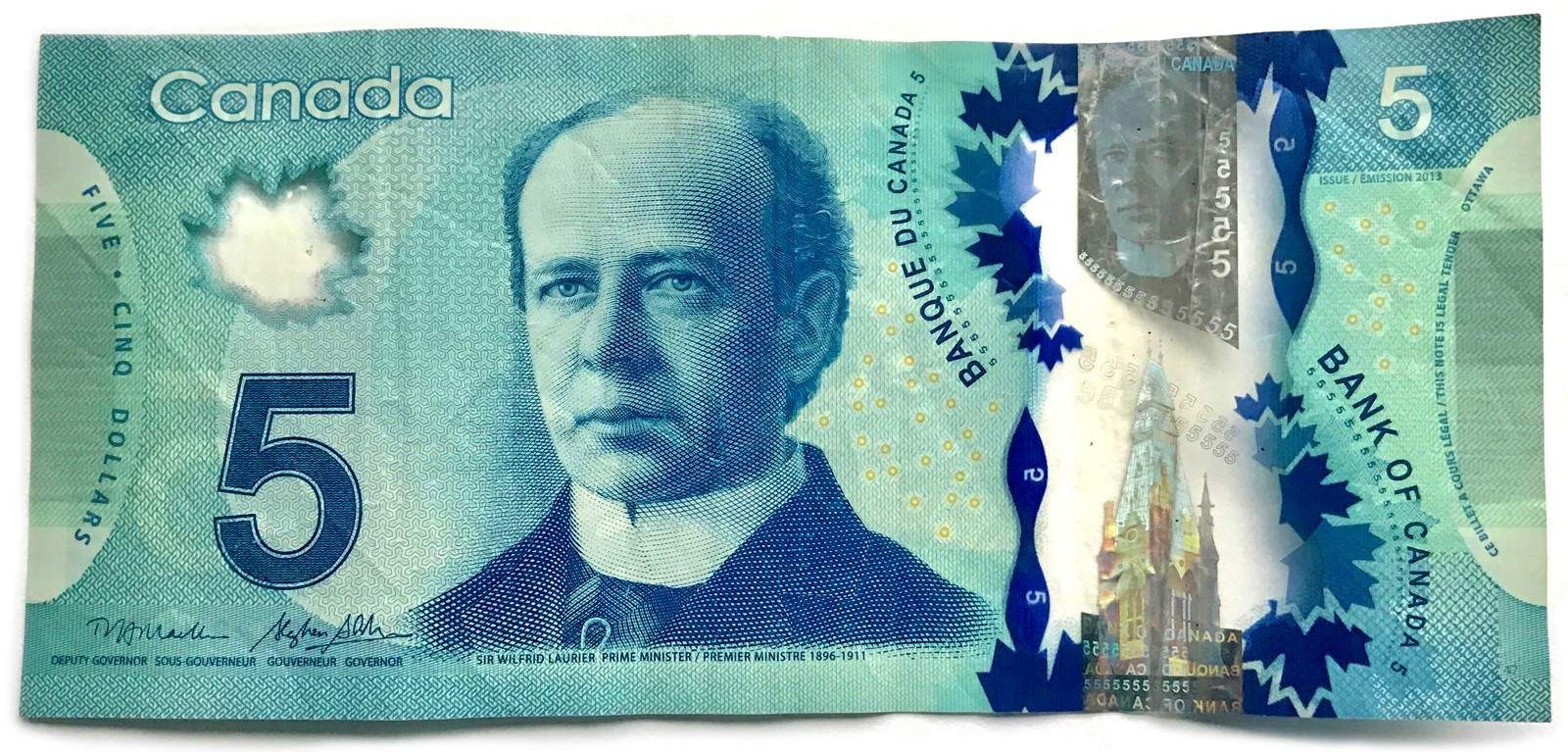 Canadian bill featuring Wilfrid Laurier and Canadarm
Canadian bill featuring Wilfrid Laurier and Canadarm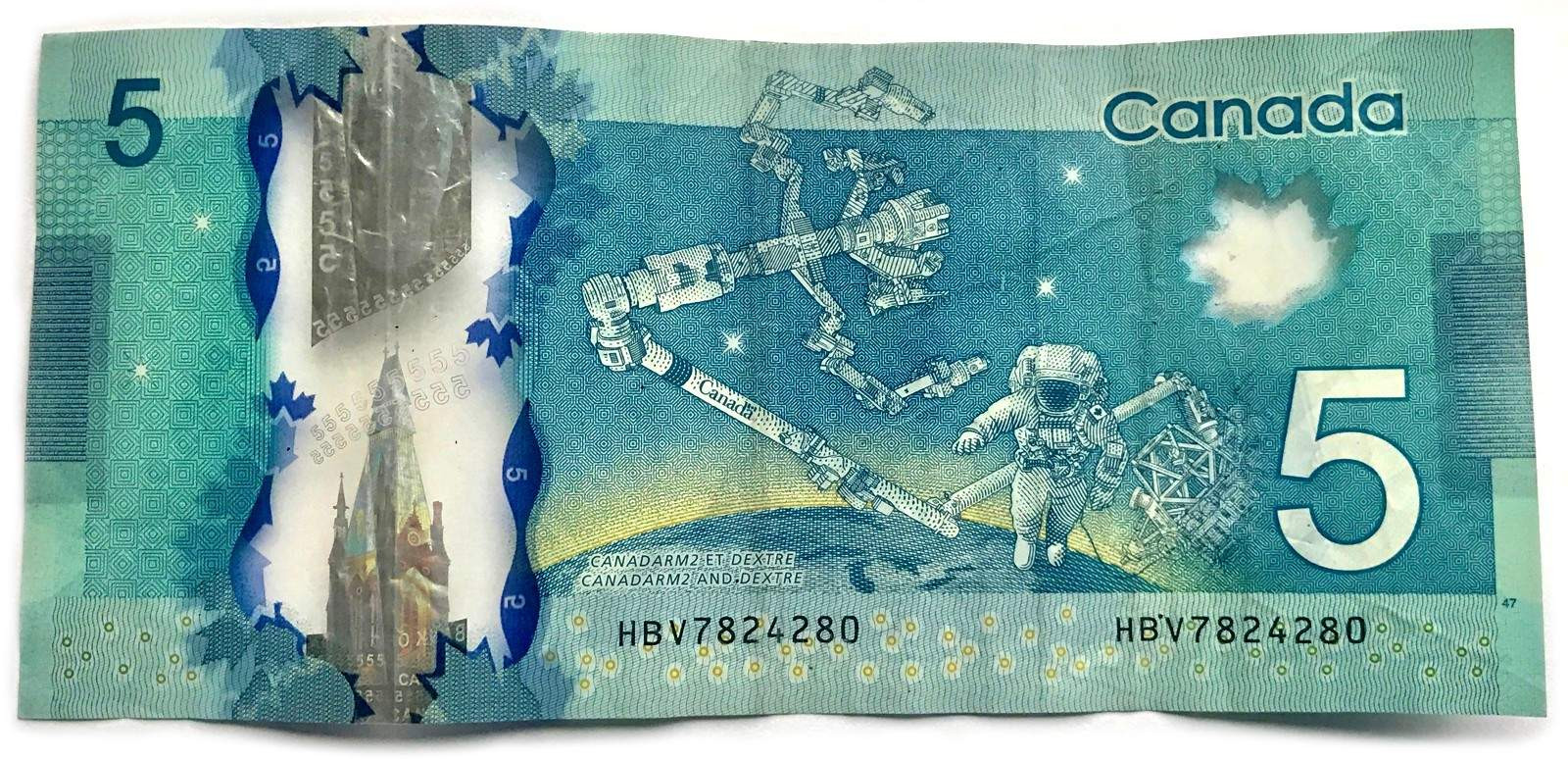 Reverse side of Canadian bill featuring Canadarm
Reverse side of Canadian bill featuring Canadarm
The blue $5 bill features Sir Wilfrid Laurier, a former Canadian Prime Minister and the first French-Canadian to lead the country. The reverse side honors the Canadarm, a robotic arm designed in Canada and used extensively in NASA’s Space Shuttle program. The Canadarm represents Canadian innovation and contributions to space exploration.
$10 Bill
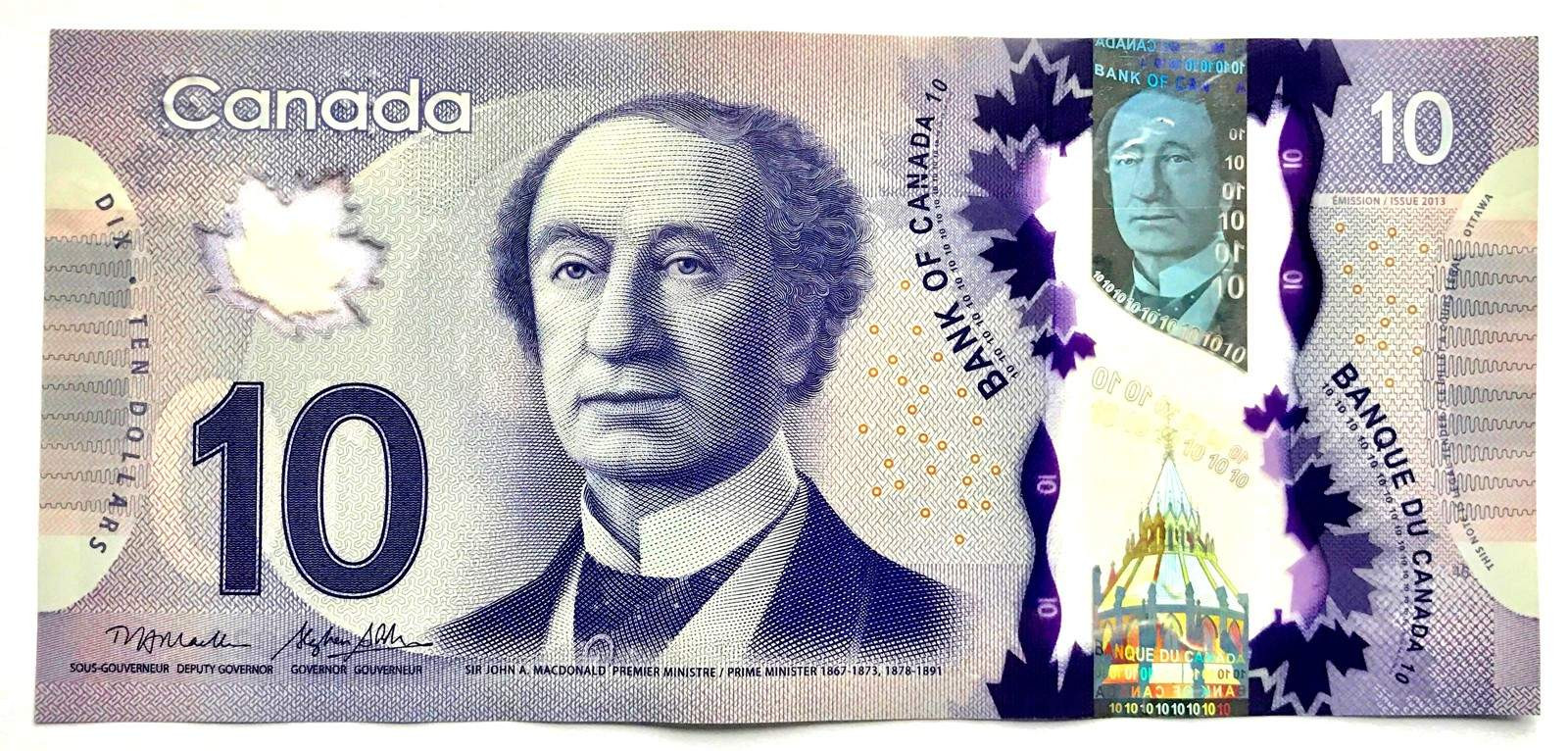 Canadian bill featuring John A. Macdonald and The Canadian train
Canadian bill featuring John A. Macdonald and The Canadian train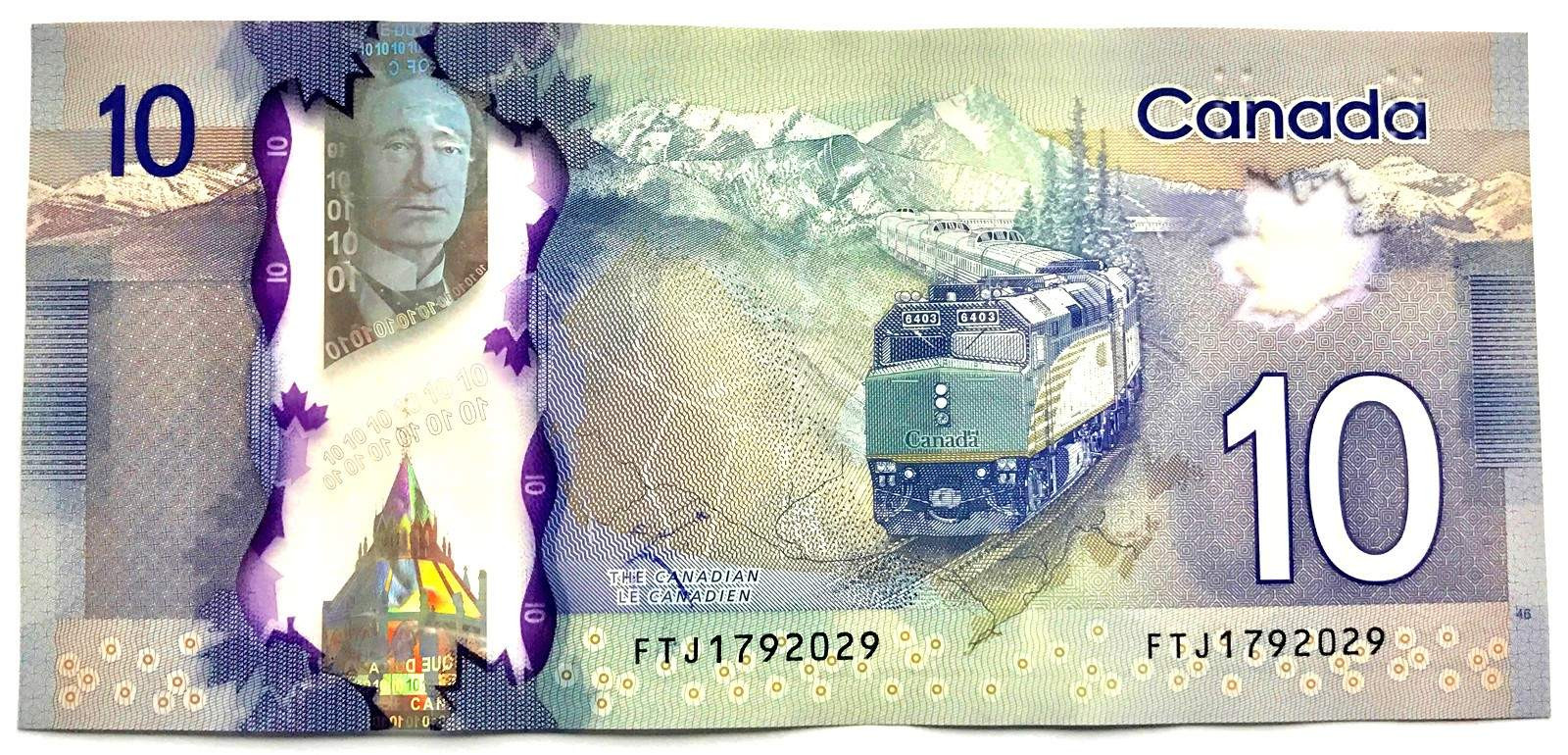 Reverse side of Canadian bill featuring The Canadian train
Reverse side of Canadian bill featuring The Canadian train
The purple $10 bill depicts Sir John A. Macdonald, Canada’s first Prime Minister and a key figure in Canadian Confederation. The banknote’s reverse celebrates the transcontinental Canadian railway, a monumental achievement of Macdonald’s era, and features The Canadian, a passenger train operated by VIA Rail, Canada’s national railway company. The railway symbolizes national unity and connecting Canada from coast to coast.
$20 Bill
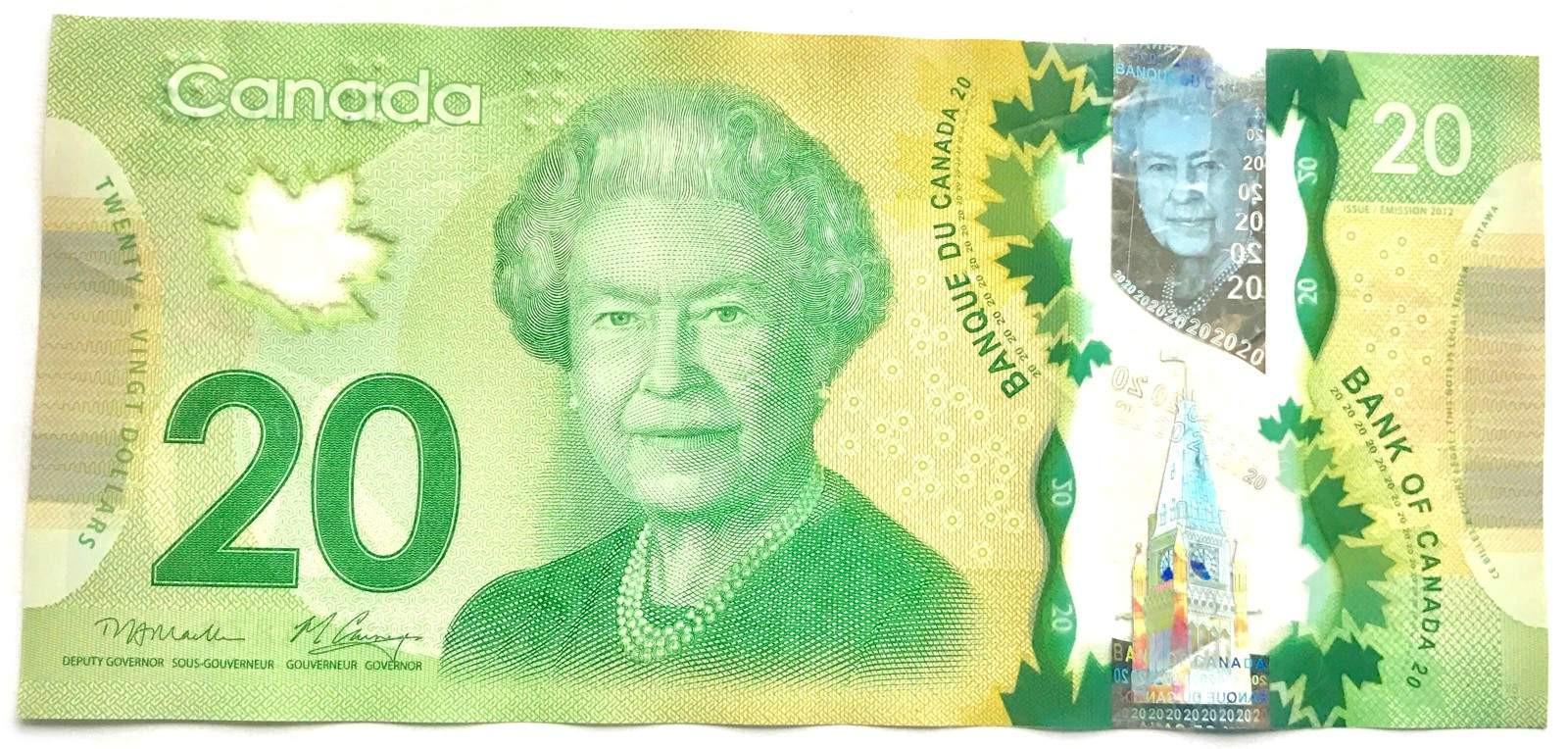 Canadian bill featuring Queen Elizabeth II and the Vimy Memorial
Canadian bill featuring Queen Elizabeth II and the Vimy Memorial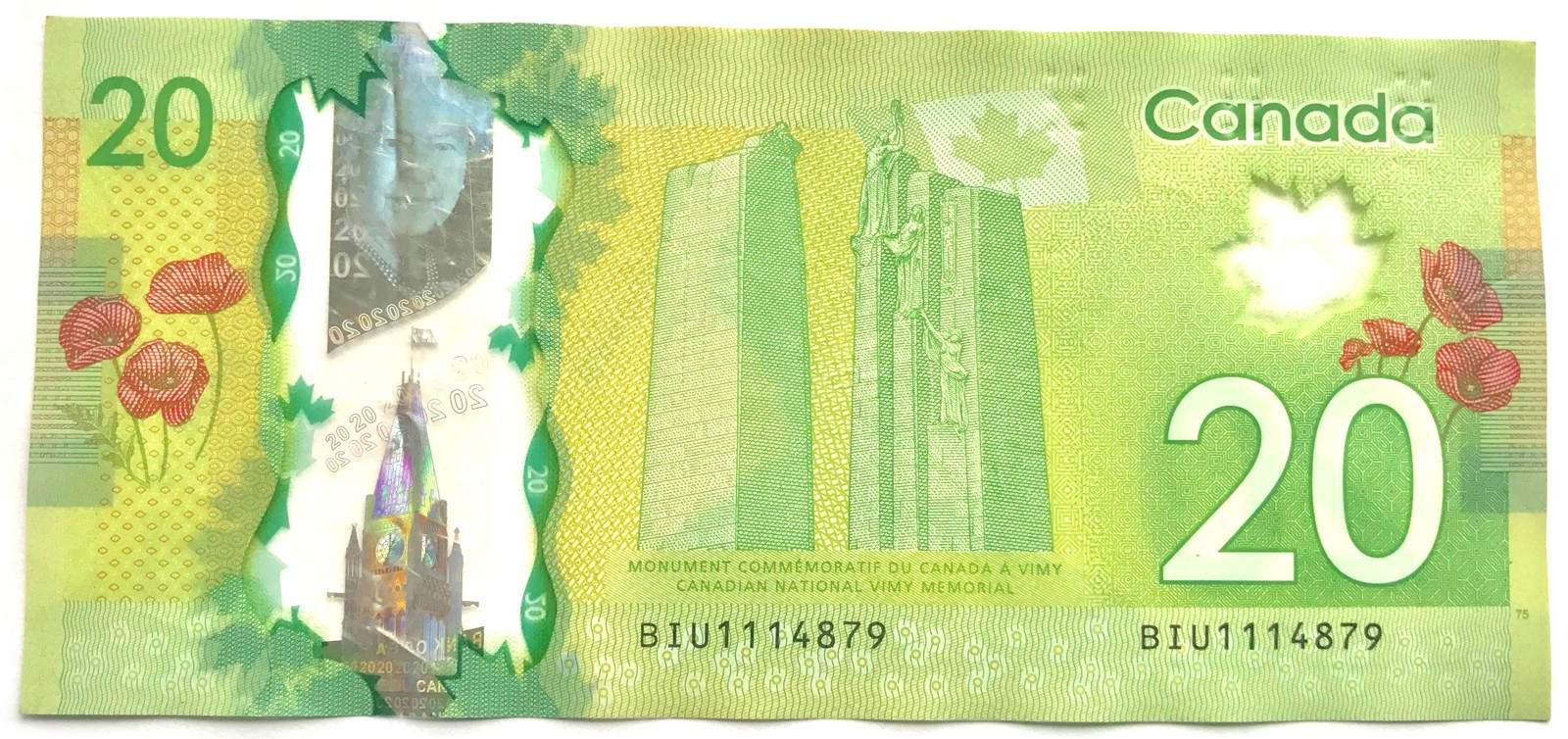 Reverse side of Canadian bill featuring the Vimy Memorial
Reverse side of Canadian bill featuring the Vimy Memorial
The green $20 bill features Queen Elizabeth II, Canada’s monarch. The reverse side commemorates the Canadian National Vimy Memorial in France, a tribute to Canadian soldiers who fought and died in the Battle of Vimy Ridge during World War I. The Vimy Memorial is a significant symbol of Canadian sacrifice and remembrance in the First World War.
$50 Bill
 Canadian bill featuring William Lyon Mackenzie King and the CCGS Amundsen
Canadian bill featuring William Lyon Mackenzie King and the CCGS Amundsen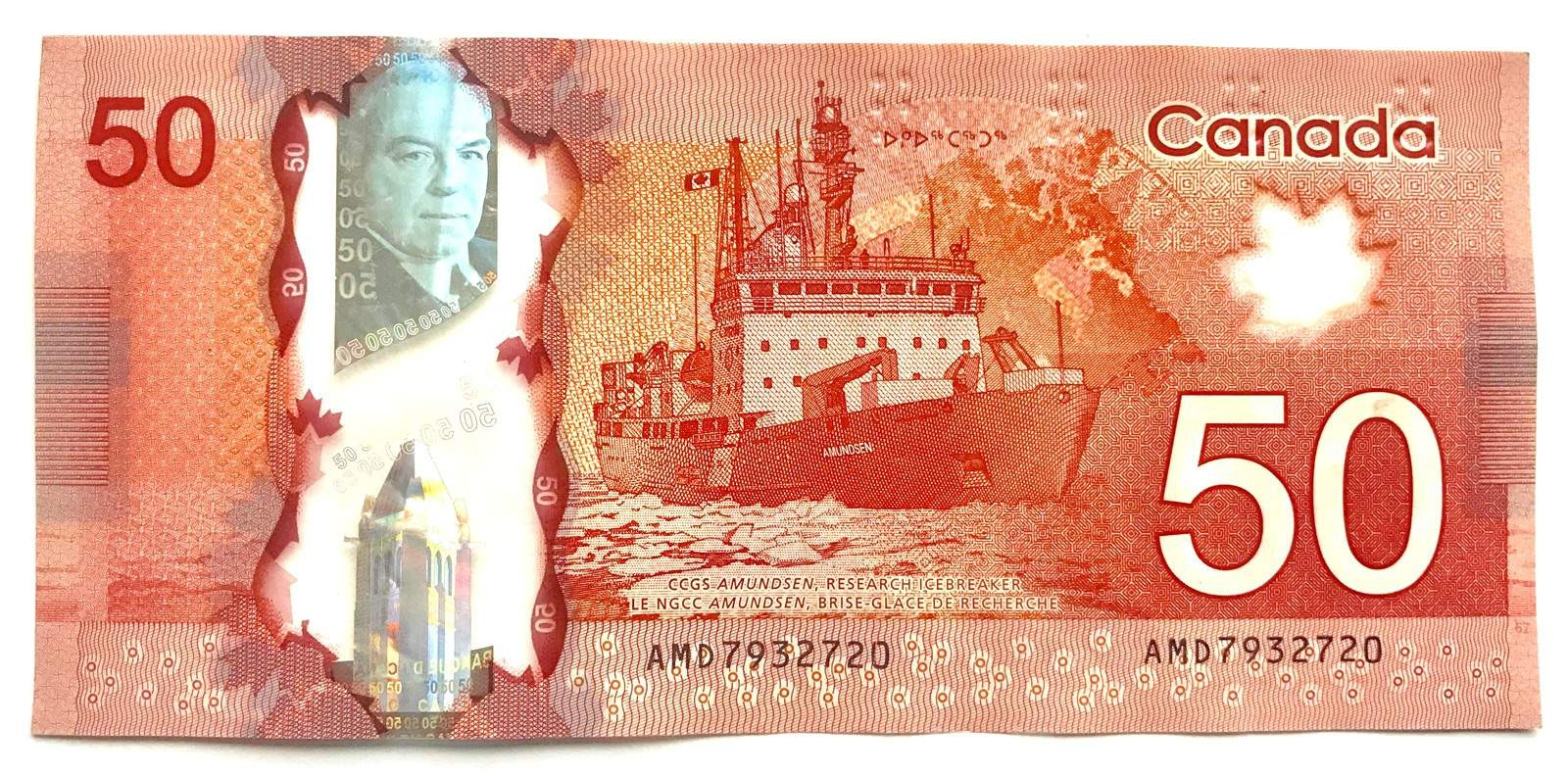 Reverse side of Canadian bill featuring the CCGS Amundsen
Reverse side of Canadian bill featuring the CCGS Amundsen
The red $50 bill portrays William Lyon Mackenzie King, Canada’s longest-serving Prime Minister, who led Canada through World War II. The reverse features the CCGS Amundsen, a Canadian Coast Guard icebreaker, representing Canadian Arctic research and exploration. The Amundsen symbolizes Canada’s commitment to scientific research in the challenging Arctic environment.
$100 Bill
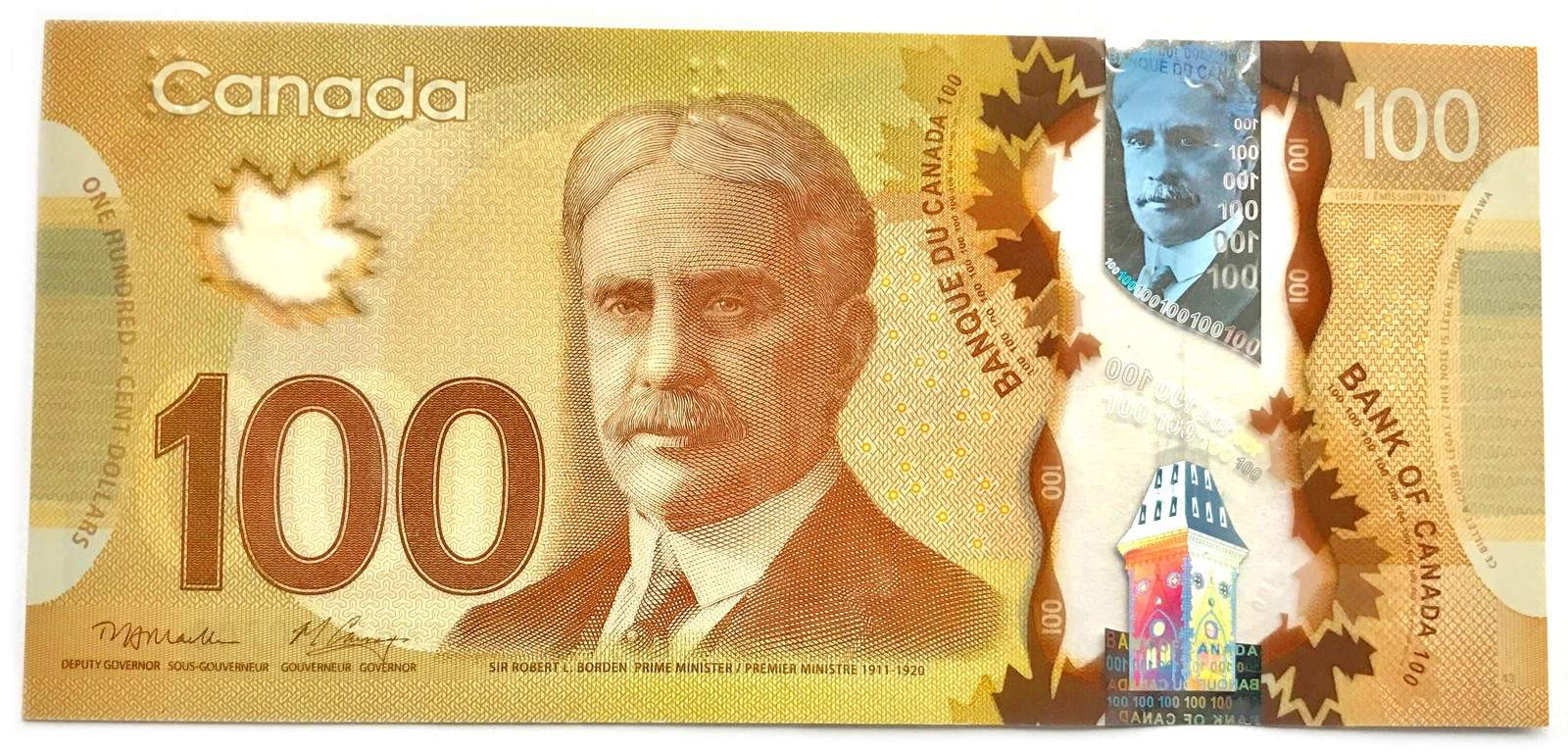 Canadian 0 bill featuring Robert Borden and insulin
Canadian 0 bill featuring Robert Borden and insulin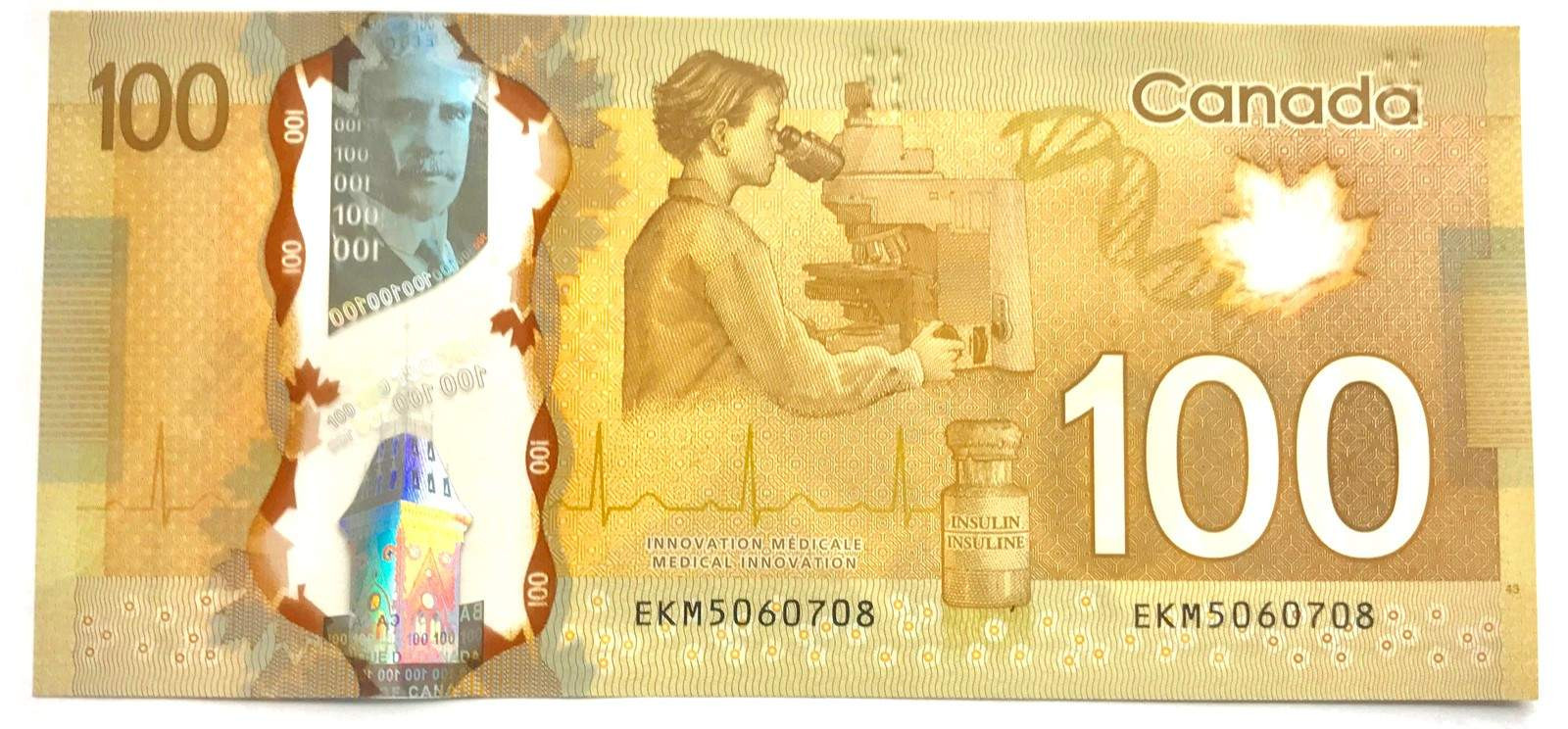 Reverse side of Canadian 0 bill featuring insulin
Reverse side of Canadian 0 bill featuring insulin
The brown $100 bill, the highest denomination currently in general circulation, bears the image of Sir Robert Borden, Prime Minister of Canada during World War I. The reverse side celebrates Canadian innovation in medicine, specifically featuring insulin, a life-saving discovery made by Canadian scientist Frederick Banting. Insulin represents Canadian contributions to medical science and improving global health.
The Discontinued $1000 Bill
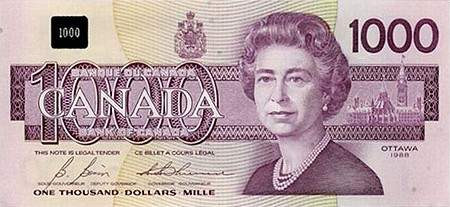 Image of an old Canadian Thousand Dollar Bill
Image of an old Canadian Thousand Dollar Bill
While rarely seen today, the $1000 bill was once Canada’s highest denomination banknote. It was discontinued in 2000 due to concerns about its use in money laundering and organized crime. Although no longer in production, some $1000 bills remain in circulation, and the government has taken steps to de-legalize them.
Key Features and Facts About Canadian Money
Beyond the individual coins and banknotes, there are some interesting general facts about Canadian money:
“D.G. Regina” and the Queen
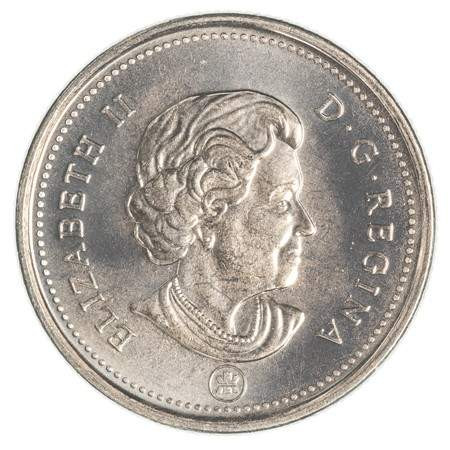 Queen Elizabeth II portrait on a Canadian coin
Queen Elizabeth II portrait on a Canadian coin
All Canadian coins feature a portrait of Queen Elizabeth II on one side, along with the Latin inscription “D.G. Regina”, which stands for Dei Gratia Regina, meaning “Queen by the Grace of God.” The Queen’s portrait is updated periodically, reflecting her changing appearance over time, allowing for a quick visual estimation of a coin’s age. This reflects Canada’s historical ties to the British monarchy and its role as a constitutional monarchy within the Commonwealth.
Polymer Material and Security
The use of polymer for banknotes is a significant feature of Canadian currency. This material makes the banknotes more durable, water-resistant, and significantly harder to counterfeit compared to traditional paper bills. Polymer banknotes incorporate advanced security features such as transparent windows and holographic elements, further enhancing their resistance to forgery and maintaining the integrity of the currency.
A Look Back at Old Banknote Series
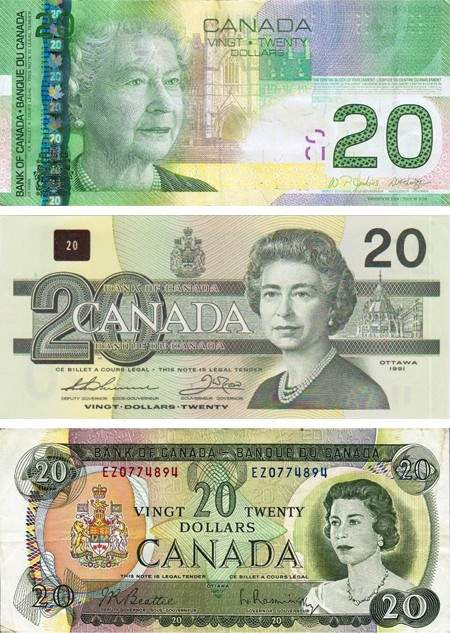 Collage of old Canadian banknotes from different series
Collage of old Canadian banknotes from different series
For many Canadians, older banknote series evoke a sense of nostalgia. Previous series, such as the Canadian Journey series, Canadian Birds series, and Scenes of Canada series, each had their own distinct designs and reflected different periods in Canadian history and artistic styles. While no longer in production, these older banknotes serve as a reminder of the evolution of Canadian currency design and the stories they tell about the nation’s past.
Conclusion: Canadian Money – More Than Just Currency
So, what is Canadian money called? It’s the Canadian dollar, but as you’ve learned, it’s much more than just a name. It’s a symbol of Canadian identity, a testament to its economic strength, and a canvas showcasing its history, culture, and values. From the loon on the dollar coin to the historical figures and national achievements depicted on banknotes, Canadian money offers a fascinating glimpse into the heart of Canada. Whether you’re a visitor, a new resident, or a long-time Canadian, understanding the nuances of Canadian currency enriches your appreciation for this remarkable nation.